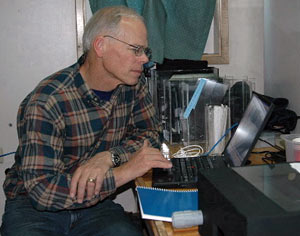Interviews

Chief Scientist Larry Madin, who has studied salps for over thirty years, examines a microscope photograph of salp anatomy. (Photo by K. Madin, WHOI)
You are here in the Southern Ocean to study salps. What are salps?
Salps are tube-shaped, soft, transparent animals that swim through the ocean, straining out plant food as they go. Salps have always been really interesting to me because they are perfect for the environment they live in: perfectly adapted for swimming and filtering their food out of the water. With a single action of pumping their muscles, they eat, swim, and breathe. Salps and other ‘gelatinous zooplankton’—jelly-like animals—are exotic, beautiful, and graceful. They look like something from outer space or another world—which they are, in a way.
How did you first find out that salps existed?
I first saw a salp during a class I took as an undergraduate. At the time I didn’t know what I was going to study yet.
This salp was dead, pickled, and in a jar—definitely not at its best. But I’d never seen anything like it before, and I was curious about how it worked. The professor didn’t know anything about them either, and I was intrigued by that. That class helped me decide to study zooplankton.
In graduate school my advisor, Bill Hamner, began to study zooplankton in their natural environment, by scuba diving in the open ocean. At the time, that was an unheard-of approach. That’s when I learned to dive—because if you want to know what these animals do, you have to go where they live.
How many research cruises have you been on?
That’s a good question—somewhere along the line I stopped adding them up! Probably 65 cruises over the years, and about 1000 dives during those—all blue water dives.
Can you tell us about blue water diving?
Blue water diving is scuba diving, but away from the coast, out in the open ocean, where the bottom is deeper than one hundred meters. Regular diving is like swimming—you can see what you swim over: solid ground, rocks, or coral. Where we dive, you can’t see the bottom. You can’t see anything but blue water all around you, even up, and you have a sense of being suspended in infinity, looking for the transparent plankton that we study.
What is plankton, and why should people study it?
Salps are part of the plankton—‘drifters’ that don’t swim strongly. Plankton plants and animals are the most abundant life in the ocean. They support the entire ocean food chain. Everything else eats them, or eats animals that eat them. We’d have no fish or whales without plankton.
Phytoplankton (plant plankton) create food by photosynthesis, and release oxygen, supplying half the oxygen in our atmosphere. They also take up carbon dioxide, which could be important if increasing carbon dioxide in the atmosphere is causing global climate change.
Zooplankton are the link between phytoplankton and fish in the ocean food web. Salps develop huge populations that can eat most of the phytoplankton out of the water, affecting the amount of food there is for other animals. We don’t have a very good understanding of plankton or ocean food webs, and every cruise helps us find out more.

As chief scientist on the cruise, Larry Madin has a lot to attend to. He sometimes misses dinner and eats at his desk in the lab! (Photo by Kate Madin, WHOI)What does will you do as Chief Scientist on this cruise?
As Chief Scientist, I organize the activities of the cruise and make the work plan for each day. I work with the ship’s captain and crew to decide where we want to take the ship to look for salps, and when and where we want to do scuba dives, both day and night. I also help the other scientists get what they need to do their work—making sure they have space, equipment, and assistance. There’s a lot of planning to do, and the Chief Scientist is the intermediate between the scientists, the captain and crew, and the Marine Projects Coordinator (MPC)—a special person on the ship who is experienced with polar operations, knows this ship and its capabilities well, and assists us with the ship’s facilities.
Why do you find ocean science important?
We humans are facing complicated problems related to how we live in the environment. We can’t solve them without knowing what’s causing them; and we can’t know what’s causing them without understanding how natural systems work. Science is about just that: finding out how the world works, in a direct way, by doing experiments.
The oceans are most of the planet, and we know very little about them. The real world of the oceans is totally different from the world most people experience—the world they see around them. The ocean is a vast, featureless, three-dimensional space, and the animals that live in it are perfectly at home in those conditions.
|


